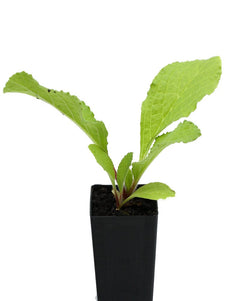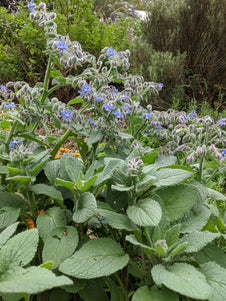











Borage
Borage
- Low stock - 2 items left
- Inventory on the way

Usually available: April to November
Life cycle: Annual
Height: 60cm - 1m
Position: Sun / part shade
Soil preference: Well drained
This is how we pack and send your Herb Plants to all states except TAS & WA
You will receive
- 1 Borage Herb Plant in a 50 X 75mm tube - General growing instructions
All of our Herb Plants are grown organically with certified organic potting mixes and fertilizers
Botanical Name: Borage officinalis
Borage is a hardy, prolific self-seeding annual, well known for its striking blue star shaped flowers during the warmer months. The large green-grey leaves are oval shaped and may be quite bristly. The stems are a similar colour but the prickly, white hairs, along the stems, create an impression of a silver coloured plant. They are positioned alternately around the hollow, hairy stem resulting in a large plant to 100cm, with a round spreading shape up to 90cm wide. The native habitat of borage was originally in Syria, but the plant is now naturalised across Europe and much of the United States.
Although the blue flowered borage is very common, there is a lesser known white borage ‘alba’ which shares many features.
Borage is a great addition to the garden and is also known to be one of the best bee and wasp attractants. It was given the nickname ‘bee’s bread’ many years ago. Your strawberry garden could benefit from the extra bee pollinators and wasps are great as predator control for other pests.
Borage was popular during the Middle Ages as a vegetable and salad herb and is still used today for culinary and medicinal purposes. The flowers, leaves and oil prepared from the seeds are all able to be utilised for different purposes.
Growing Conditions
Borage is very easy to grow and tolerates a wide range of Australian conditions. The plant grows 60-100cm high and can have quite a straggly growth habit. It may be best planted in groups so that the plants help to support each other. The delightful blue star flowers appear through the summer months and the plant will die down towards mid-year, as winter arrives.
In sub-tropical climates, borage grows best through the cooler months and will flower from early spring to early summer. Borage will accept sunny to semi-shade positions and will benefit from wind protection, so they don’t blow over. Cultivated ground is preferred, but not an absolute requirement. In fact, the blue flower colour seems to be more intense when grown in poorer soils. The plant also tends to be smaller in nutrient deficient soils.
It is nice to begin with healthy plants each season, but you can try to grow your own. Direct seeding from October to December will work well, with little effort on your part. Just cover the seeds lightly with soil and add water! After the first season, borage should self-seed and reappear each year. Choose a position where the soil is loose, friable and moist if possible. Borage tolerates clay soils, if they are not so damp as to create ‘wet feet’. Due to its prolific spreading habit, some gardeners prefer to restrain borage in pots.
Medicinal Uses
Borage has been used medicinally since ancient times, but not all the traditional medicinal uses of borage have been given support by medical research. The active ingredient in borage oil is Gamma Linolenic Acid (GLA) which, after being transformed by the body into a hormone like substance, has a number of effects. These include anti-inflammatory actions, thinning of blood vessels and vasodilation. Borage actually has the highest amount of GLA of any plant. Since ancient times, borage has been called a mood lifting herb, however its main health benefits have been found in treating Rheumatoid Arthritis (RA), lung function and/or decongestion, promoting growth of premature infants and topical application to eczema dermatitis skin conditions. There may be some benefit to kidney function as the leaves have a mild diuretic function. Borage has also been used to treat fevers, diabetes, PMS, as a general detoxification herb and for a variety of other conditions.
Culinary Uses
Young borage leaves have a refreshing cucumber flavour and may be used in salads, soups, sauces and drinks, including tea infusions. There are a great many borage recipes including something for wine drinkers and even desert lovers. It is best to pick them before flowering, so they do not develop too many prickly hairs.
Borage flowers are edible and can be used as a garnish for salads, dips and soups. You can make ice cubes by setting the flowers in water, then chill and decorate your summer drinks. Adding the flowers to herbal vinegar will create a delightful pale violet colour.
Companion Planting
Beneficial: Tomatoes, squash, strawberries, legumes, spinach, brassicas and/or anywhere in the garden. Borage is thought to deter tomato hornworms and cabbage worms and is very useful to most plants as a protector against pests and disease. It is also a useful addition to the compost heap.
All information provided on this website is for informational purposes only. Please seek professional advice before commencing any treatment.





